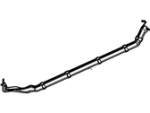I realize that I'm way overdue for an update on the project. A lot of things continue to progress on the car as I continue to collect parts. One of the parts that is becoming scarce are the taillights. As I progress through my project a few of us are in the same boat and we've been trading efforts so that we can accomplish more as a team. The group was perplexed with getting taillights, and thusly I was tasked with finding a taillight solution. As some of you have probably figured this out, I love a challenge and this was going to be a challenge. Well, after three months of design and prototyping, I have the solution and am thrilled with how it turned out. Follow through with me and hopefully you feel the same way by the end of this.
I started with a Broken right taillight and took it apart.
I was able to reverse engineer the housing and printed my prototype. As well as the reflector inside the housing. After examining the circuit that Ford used, I was able to come up with something using modern technology. I Considered the that the lights needed to be able to operate from 8-14V while maintaining a constant brightness. Also the brake lights and parking lights are the same, so the circuit has to manage the multiplexing of these signals. My last consideration was that Ford used an incandescent reverse light on the stock taillight. This was probably done because it is less expensive and probably doesn't get that much use in the life of the car compared to brake and parking lights. I figured that since I'm designing a circuit anyway, I might as well make the reverse lights LED's as well. I mocked up my circuit on a breadboard first using some pots so that I could experiment with brightness to match the stock look.

The stock taillights use 16 LEDS surrounding the reflector and I chose the brightest unidirectional ones that I could find that fit my requirements. The picture doesn't do justice here, but the lights were so bright at the highest limit that it blinded me. These will work just fine. Below is the final product attached to its cover plate. It takes up a lot less room than the original electronics. I also took care to seal the housing with an O-Ring.
The stock housing has plastic bayonets on it and the Ford work instructions suggest that once the taillight has been removed, it should be replaced because these connection points are designed to have the nut cut into them. Once these are used a few times the plastic is chewed up and there is no material left for the nut to engage with! I decided to use metal studs in my design so that the lights can go on and off as many times as I wish. Below are front and back pictures of mine next to the stock taillight.


What do you think? Ok, here comes the fun part. What the heck am I going to do for a lens? After doing a bunch of research on resin casting, I decided that I was going to attempt it and bought the materials to do just that. This lens would be particularly difficult because the center of the lens is clear while the surround is red. I originally thought that maybe the clear lens was glued into the red housing but after doing my homework learned that the red was injected around the clear lens and they are actually bonded together as a single piece. (what did I get myself into?) I figured that I would start with casting the entire lens as a single piece and then harvest the center out of the first casting. I met a few people along the way that guided me through the mold building process. Ultimately there would be two molds to make one for the clear center and one for the red larger portion.



This clear lens was the first one. The edges still have the flashing on it. This clear lens might look pretty cool with the red LEDS behind it, but I'm going for the factory look. I'll spare the details of the entire process, but below is the lens after being removed from the mold.
The fidelity is excellent and you can actually read the part numbers from Guide who made the original lens. There is a light haze in the lens from the release material and it will have to be polished a little, but some people would not even notice. Now I attach the lens to the housing and try it on an actual car for proper fit and function.
I will update with more pictures on the actual car, which will happen this week and then if everything looks good, I am moving onto casting the left light. If anyone else is building a GT and having the same taillight conundrum, reach out to me.



